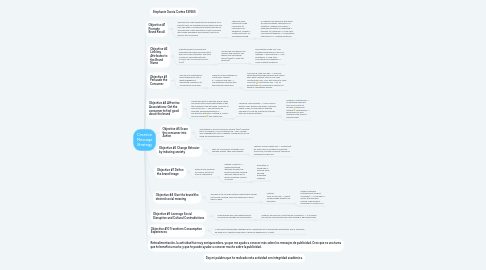
1. Retroalimentación, la actividad fue muy enriquecedora, ya que me ayudo a conocer más sobre los mensajes de publicidad. Creo que es una tarea que te beneficia mucho y que te puede ayudar a conocer mucho sobre la publicidad.
2. Objective #1 Promote Brand Recall
2.1. The goal is to make consumers to remember your brand´s name. By repeating a brand name over and over, the odds of recalling that brand name go up. The intention of the advertisers is that consumers have brand awareness and achieve to be top of mind of the consumers.
2.1.1. There are some methods to make consumers to remember you: Repetition, Slogan & Jingles and Point- of- Purchase Branding.
2.1.1.1. Is important to remember that there are some strategic implications of repetition, slogans and Jingles: 1. Extremely Resistant to forgetting. 2. Efficient for consumer. 3. Long-Term commitment/expense. 4. Competitive interference. 5. Creative resistance.
3. Objective #2 Link key Attributes to the Brand Name
3.1. Advertisers want consumers to remember the brand and associate it with one or two attributes. This type of brand is associates with the UNIQUE SELLING PROPOSITION (USP).
3.1.1. The primary mechanism are memory and learning. The appeal may be through words (copy) or visits (art direction).
3.1.1.1. The method is with USP. The strategy implications of the USP methods: 1. Big carryover. 2. Very Resistance. 3. Long-term commitment and expense. 4. Some creative resistance.
4. Objective #3 Persuade the Consumer
4.1. This style of advertising is about arguments. This is hight engagement advertising. The goal is to convence the consumer.
4.1.1. There are some methods for convincing: Method A-->Reason Why Ads--> The advertiser reasons with the potential consumers.
4.1.1.1. METHOD B: Hard-Sell Ads--> They are characteristically high pressure and urgent, thus "hard". Phrases such as "act now" "limited time offer, "your last chance to save". METHOD C: Comparison Ads-->Try to demonstrate by comparing its features to those of competitive brands.
5. Objective #4 Affective Associations: Get the consumer to feel good about the brand
5.1. Advertisers want to like their brand. There are several well-known approaches to get get consumers feel the brand. METHOD A: Feel-Good Ads--> The ads works by affective feelings association or pre-decision distortion. Method B: Humor Ads and Method C: Sex Appeal ads.
5.1.1. Method E: Demostration--> How close an electric razor shaves, how green a fertilizer makes a lawn, or how easy an exercise machine is to use are all product features that can be demonstrated.
5.1.1.1. Method F: Infomercials--> An advertiser typically buys from five to 60 minutes of television. Method D: Testimonials--> spokespersons who champions the brand in advertisement.
6. Objective #5 Scare the consumer into Action
6.1. The strategy is to illicit a specific feeling (fear). Example: Buy y to prevent x. Some methods are-- Fear- Appeal Ads: Highlights the risk or negative consequences of not using the advertising brand.
7. Objective #6 Change Behavior by inducing anxiety
7.1. They try to minimize, moderate, and alleviate anxiety. They avoid anxiety.
7.1.1. Method: Social Anxiety ads--> Anxiety ads are often used in context of important social roles, and the consumer´s perceive inadequacy in that role.
8. Objective #7 Define the brand Image
8.1. Refers to the meaning of a brand, but at the level of impressions.
8.1.1. Method: Image Ds--> Image advertising attempts to distill the brand´s essential meaning with very sparse use of words and heavy reliance on visuals.
8.1.1.1. Evaluation of image ads is typically done through qualitative methods.
9. Objective #8 Give the brand the desired social meaning
9.1. The have to try to make material objects that already carry some meaning, have the meaning you want them to have.
9.1.1. Method: Slice-of-life-ads--> depict an ideal usage situation for the brand.
9.1.1.1. Method: Branded Entertainment product Placement--> In the age of media, the have well beyond a few product placement in movies in TV.
10. Objective #9 Leverage Social Disruption and Cultural Contradictions
10.1. Great brands have used advertising to successfully leverage social disruption.
10.1.1. Method: Tie Brand to Social/Cultural Movement--> It is seeing the cultural land beneath your feet shifting in significant ways.

